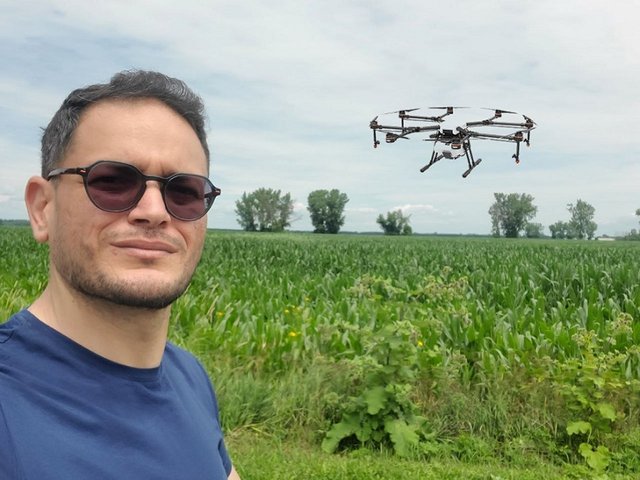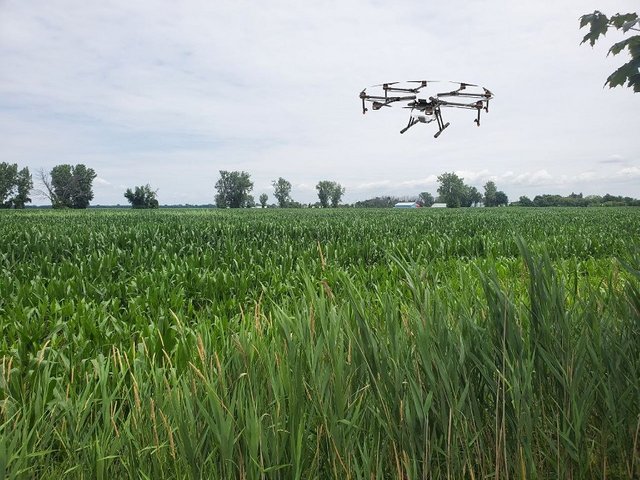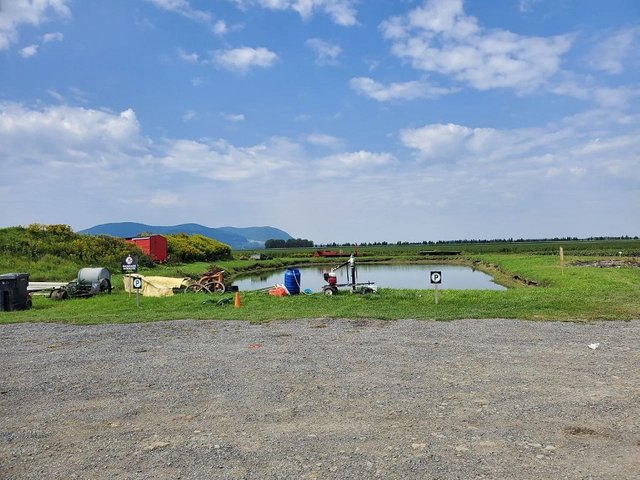SEC | S20W6: "The Use of Drones in Agriculture"
Hello steemians,
What role have drones (unmanned aerial vehicles) played in modernizing agriculture? Use your country as an example if applicable.
I think that drones have brought a real revolution in agriculture in Tunisia by facilitating the management of land and crops on large areas without requiring physical travel to the field, which represents a considerable advantage in terms of time and effort because thanks to this technology we can now monitor fields regularly and precisely by obtaining real-time information on the state of the crops, which allows us to quickly detect potential problems such as plant diseases or lack of water even before visible signs appear, which helps to anticipate risks and react more quickly to agricultural challenges while modernizing my practices and making agriculture more efficient and effective.
I also note that drones have significantly improved the efficiency of irrigation in Tunisia, a country where water is a precious resource and where its management is crucial to ensure optimal and sustainable agricultural yields because thanks to the precise data provided by the drones I can adjust with great precision the quantities of water brought to the different plots according to their specific needs, which not only significantly reduces water waste but also ensures a better distribution of this vital resource for my crops, which is a major asset in the modernization of agricultural practices in my country where climatic and environmental challenges require adapted and efficient technological solutions to guarantee the sustainability of farms.
I also note that drones play a crucial role in optimizing the use of fertilizers and phytosanitary products because they allow us to precisely target the areas that need them based on analyses carried out in the field and this not only improves the effectiveness of these interventions but also reduces the costs related to these agricultural inputs, which are often expensive in Tunisia, which is particularly useful in a context where it is necessary to maximize yields while limiting environmental impacts because based on the images and data provided by the drones, we can decide more precisely when and where to intervene, which allows us to adopt a more rational and sustainable approach to agriculture in Tunisia where this sector remains key to the economy and the future of the country, which helps me maintain high yields while respecting the environment and adopting modern and efficient agricultural practices.
How do drones contribute to precision and efficiency in agricultural practices? What are the key benefits of using drones in agriculture?
I believe that drones contribute significantly to precision and efficiency in agricultural practices by allowing us to monitor crops with great accuracy and in real time, which gives us the ability to obtain detailed data on the state of the soil and plants without having to physically go to the site, which is particularly useful for large agricultural areas where it would be difficult and time-consuming to inspect everything manually. Thanks to these drones, we can not only quickly identify areas of water stress or problems related to plant diseases, but also adapt my interventions in a much more targeted way by using, for example, the information collected to adjust irrigation or the application of fertilizers, which improves not only the health of the plants but also their overall yield, which is crucial to maximize agricultural production in Tunisia where resources are limited and where it is important to optimize each hectare of land.
Using drones can also increase the efficiency of agricultural operations because these tools allow better management of agricultural inputs by minimizing waste and concentrating efforts where they are really needed, which is particularly advantageous for us because it reduces costs while improving the impact of treatments, whether for irrigation, fertilization or even phytosanitary treatments.
I also find that one of the main advantages of drones in agriculture is the speed with which they allow data to be collected and analyzed, which helps me make informed decisions more quickly by avoiding significant losses caused by late reactions to problems detected in the field. In Tunisia where the climate can be unpredictable and conditions can change quickly, drones allow us to anticipate the needs of my crops by adjusting practices before situations become critical, which improves not only the productivity but also the profitability of our farms. In addition, this technology gives us constant access to accurate and up-to-date data, which makes all of our agricultural practices more efficient and allows us to maximize the use of resources while maintaining sustainable and competitive agriculture.
How do drones help manage soil moisture and nutrient levels in crops?
Also I notice that drones are extremely effective tools to help us better manage soil moisture and nutrient levels in crops because they allow us to collect precise data on the state of the soil and plants at different times of the growing cycle. Thanks to these sensors integrated into drones, we can regularly monitor fields and detect areas where the soil lacks moisture, which allows us to adjust the irrigation system accordingly in order to avoid wasting water and ensure optimal use of this essential resource, particularly in Tunisia where water is a rare and precious resource.
In addition drones provide us with detailed information on the levels of nutrients present in the soil, which allows us to better plan fertilizer applications. We can thus target the plots that need it most and adjust the doses precisely thus avoiding deficiencies or excesses of nutrients that could affect plant growth. This finer management of nutrients thanks to drones makes it possible to improve crop productivity while reducing the costs associated with the use of fertilizers.
Using this data provided by drones, we can anticipate crop needs and adapt agricultural practices in real time, which helps us maintain optimal growing conditions for plants. Drones therefore offer better overall management of moisture and nutrients, which helps to maximize yields and ensure more sustainable agriculture in Tunisia, where efficient resource management is crucial to meet the country's agricultural challenges.
Explain the significance of multispectral and hyperspectral imaging sensors in agricultural drones.
Multispectral and hyperspectral imaging sensors integrated into agricultural drones are considered to be of great importance because they allow us to analyze crops in a much more precise way than we could do with the naked eye. These multispectral sensors give us the ability to capture different wavelengths of light that plants reflect, which tells us about their overall health, especially regarding their ability to absorb water and nutrients. Using this technology, we can spot early signs of water stress or nutrient deficiency, allowing us to intervene more quickly to correct the situation before the plants actually suffer.
Hyperspectral sensors go even further by giving us a much more detailed analysis of plants by capturing a wider range of wavelengths, which helps us identify problems such as diseases or pests long before these signs are visible. Thanks to these sensors we can obtain detailed data on the composition of plants and thus better understand their physiological condition which allows us to adjust our agricultural practices very precisely, whether it is fertilization, irrigation or protection against pests.
How drones help in soil mapping and why is it important for precision farming?
That's clear that drones are playing a vital role in soil mapping by allowing us to collect extremely precise data on soil characteristics such as texture, moisture and chemical composition. By using drones for this task, we can quickly and efficiently obtain an overview of variations within a field without having to carry out physical tests which are often time-consuming and costly. This information helps us to better understand the specificities of each area of our farm, which is essential for adjusting our farming practices according to the specific needs of each plot.
Soil mapping by drones is particularly important for precision farming because it allows us to divide our fields into micro-zones based on the data collected, in order to adapt irrigation, fertilisation or seed use in a much more targeted and efficient way. This means that we can bring the exact quantities of resources to where they are needed reducing waste while improving crop quality. In Tunisia, where water and nutrient resources are limited this ability to optimize the use of inputs is particularly crucial to maximize agricultural yields while preserving the environment.
By mapping the soil with drones, we benefit from a more detailed understanding of the characteristics of our land which helps us better manage risks such as erosion or salinity and make informed decisions for crop rotation or improving cultivation practices. This contributes to making our agriculture more sustainable and more resilient to environmental challenges. We can thus adapt our agricultural strategies proactively which is essential for the future of agriculture in Tunisia, where the sustainability of agricultural practices is increasingly important to ensure long-term food security.
Thank you very much for reading, it's time to invite my friends @graceleon, @simonnwigwe, @josepha to participate in this contest.
Best Regards,
@kouba01




Upvoted. Thank You for sending some of your rewards to @null. It will make Steem stronger.
Observations and suggestions:
Drones are one of the best tools for managing multiple fields simultaneously and controlling and identifying field diseases. Good to know that agriculture is being improved using drones in Tunisia. We can call drones a boon for crops. A person who can predict crops using drones is really more advanced and will improve the use of drones in agriculture. Yes, drone irrigation and fertilizer management do everything right, measuring plant nutrients. The role of drones is immense especially for identifying insects. Yes, you are right that drones can provide theory by transferring wings much faster but I think it requires a well-meaning drone. You are right but drones do a great job in avoiding water wastage sir. Multispectral and hyperspectral imaging sensors are very important but we can compare these two with human sensors. Your ideas about drones are very strong. Hope you discuss something good about drones with us.
Feedback:
Congratulations on bringing a quality content. You have earned a positive vote from team 2, and it is delivered by @starrchris.
Many Blessings...🙏🏻
Los drones son una herramienta indispensable para nuestro cultivo porque a través de ellos podemos revisar nuestros siembra